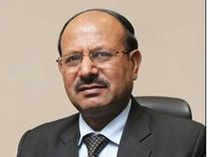
A year ago, steel companies were in enviable place, demand was strong, realisations were strong, global demand was high. Now demand as well as prices are very low. Would things improve or is the problem here to stay?
The situation of the country is not very different from the international market. There is a global recession in the field of investments, consumptions and everywhere else. But I would say that we in JSPL are a little comfortable than the industry because of value-added products. We are primarily in rails, in speciality plates for defence and for very special applications. We are in very speciality wire rods and that is helping us sail through.
In which segment has demand dropped for JSPL -- railways, construction?
Railway demand is very stable. We are fully booked for next 12 months and the speciality plates from L&T, BHEL and from other major infrastructure building industry like ship building. We are fully booked for next five to six months. There is no problem. Then there are some other speciality plates like quenched and heat treated plates.
These plates are being used for very special applications which I cannot reveal. This is very secret in the interest of the country, but we have orders for all the speciality plates also. As far as structurals are concerned, the honourable prime minister has already declared a Rs 100 lakh crore budget for the infrastructure industry.
Your other question was in which area the demand has fallen. The demand is less in the area of steel for construction grade like TMT, re-bars. All such products are under pressure but in the last 10 days, we have found a positive sign from secondary as well as the primary steel industry. The prices have gone up and that shows that demand is picking up.
The other major factor is today there is a flooding situation in Madhya Pradesh, Chhattisgarh and in Maharashtra and Gujarat. Maharashtra and Gujarat are very developed states and they consume a lot of steel. So does MP. But because of heavy floods, construction has stopped but again there is a blessing in disguise. We will see a big demand coming up from all these three-four states which are flooded today.
If we are talking about demand, is your value-added capacity, particularly in case of rail, fully booked for orders? Do you have any exposure in auto?
Today everybody is speaking about auto industry and auto industry, of course, is in big trouble, more so, because of some of the news in the media that EV vehicles are coming.
Honourable minister Nitin Gadkariji has already explained that EVs are not going to replace the diesel and petrol vehicles. The moment we qualify for Bharat VI, the overall pollution level will be reduced dramatically. EVs are vehicles of the future. It will take some time because the charging points, the facilities and the road test etc have to be proven.
Gadkariji has already declared that he is going to speak to the finance ministry for reducing GST on the existing vehicles which are run on petrol or diesel. Today it is 28%. It should not be more than 12% in my personal view. Similarly, rate on steel is today at 18%, the steel industry should be given a special package by the Government of India, wherein the raw materials can be at 18% and the finished goods can be 15%.
If that 3% of delta is given to the industry at least for the next five to six months, then that will be good for the entire industry. As far as JSPL is concerned, we are a speciality product supplier and producer. We supply to railways, shipbuilding industry, defence and industry like BHEL and L&T, which are frontrunners in the nation’s growth.
We are not exposed to auto industry too much but directly or indirectly, when steel consumption goes down, then everybody is affected. Some of the manufacturers, who are supplying to auto industry, will try to enter other areas if auto sector is not doing well. But at the moment, the auto industry is on the right track.
How much of your debt is coming up for maturing in FY20? What exactly is your plan to service the same?
Debt is a financial mechanism. No industry will survive without debt, but how much debt is the question. The more you grow, the more debts will come, more profit you will make and more prepayments you will do. We were at Rs 39,000 crore in the beginning of the year and we will close at about Rs 34,000 crore by the end of this year. We will reduce debt by Rs 5,000 crore.
However, we are not investing in capex. There is no increase in debt because there is no capex on the anvil.The policy we have opted for is called earn and invest. So, whatever we earn out of our EBITDA and out of our profits, a part of that will go to capex. The main aim is to sweat out the existing facilities and we are sure we will be in a position to do that.
Download The Economic Times News App to get Daily Market Updates & Live Business News.
Subscribe to The Economic Times Prime and read the Economic Times ePaper Online.and Sensex Today.
Top Trending Stocks: SBI Share Price, Axis Bank Share Price, HDFC Bank Share Price, Infosys Share Price, Wipro Share Price, NTPC Share Price
Read More News on
Download The Economic Times News App to get Daily Market Updates & Live Business News.
Subscribe to The Economic Times Prime and read the Economic Times ePaper Online.and Sensex Today.
Top Trending Stocks: SBI Share Price, Axis Bank Share Price, HDFC Bank Share Price, Infosys Share Price, Wipro Share Price, NTPC Share Price
















 Get Unlimited Access to The Economic Times
Get Unlimited Access to The Economic Times
